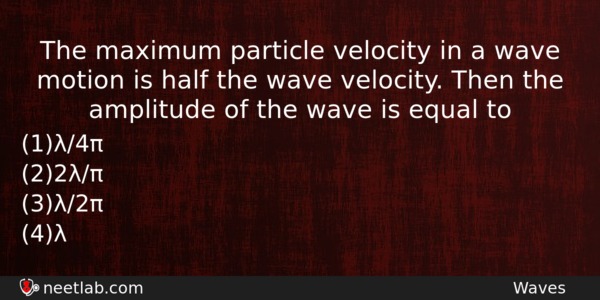| ⇦ | 
| ⇨ |
The maximum particle velocity in a wave motion is half the wave velocity. Then the amplitude of the wave is equal to
Options
(a) λ/4π
(b) 2λ/π
(c) λ/2π
(d) λ
Correct Answer:
λ/4π
Explanation:
For a wave, y = a sin [(2πvt/λ) – (2πx/λ)]
Here v = velocity of wave
.·. y = a sin [(2πvt/λ) – (2πx/λ)]
dy/dt = a (2πv/λ) cos [(2πvt/λ) – (2πx/λ)]
velocity = (2πav/λ) cos [(2πvt/λ) – (2πx/λ)]
Maximum velocity is obtained when
cos [(2πvt/λ) – (2πx/λ)] = 1
.·. v = (2πav/λ)
Then, v = v/2
(2πav/λ) = v/2 or a = λ/4π.
Related Questions: - In Young’s double slit experiment, the locus of the point P lying in a plane
- Consider two nuclei of the same radioactive nuclide. One of the nuclei was created
- A parallel beam of light of wavelength λ is incident normally on a narrow slit
- A 220 volt and 1000 watt bulb is connected across a 110 volt mains supply.
- The number of beta particles emitted by a radioactive substance is twice the number
Topics: Waves
(80)
Subject: Physics
(2479)
Important MCQs Based on Medical Entrance Examinations To Improve Your NEET Score
- In Young’s double slit experiment, the locus of the point P lying in a plane
- Consider two nuclei of the same radioactive nuclide. One of the nuclei was created
- A parallel beam of light of wavelength λ is incident normally on a narrow slit
- A 220 volt and 1000 watt bulb is connected across a 110 volt mains supply.
- The number of beta particles emitted by a radioactive substance is twice the number
Topics: Waves (80)
Subject: Physics (2479)
Important MCQs Based on Medical Entrance Examinations To Improve Your NEET Score
18000+ students are using NEETLab to improve their score. What about you?
Solve Previous Year MCQs, Mock Tests, Topicwise Practice Tests, Identify Weak Topics, Formula Flash cards and much more is available in NEETLab Android App to improve your NEET score.
Share this page with your friends

Since max. Particle velocity= aω
Wave velocity = ω/k
Acc to que
aω = 1/2 (ω/k)
Solving ,
a = 1/2k
Since k= 2π/ λ
Hence a = λ/4π